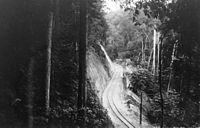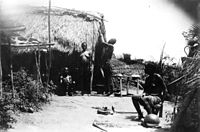Congo–Ocean Railway
| Congo-Ocean Railway line | |||
|---|---|---|---|
| Overview | |||
| Status | Operational | ||
| Locale | Pointe Noire,Bouenza,Kouilou,Niari,Pool,Lékoumou | ||
| Termini | |||
| Stations | 49 | ||
| Service | |||
| System | Non-Electrified | ||
| Services | ViaDolisie | ||
| History | |||
| Opened | 1934 | ||
| Technical | |||
| Line length | 512 km (318 mi) | ||
| Number of tracks | 1 | ||
| Character | At-grade | ||
| Track gauge | 1,067 mm(3 ft 6 in) | ||
| Electrification | No | ||
| Operating speed | 40 kilometres per hour (25 mph) | ||
| |||
TheCongo–Ocean Railway(COR;French:Chemin de fer Congo-Océan,CFCO) links the Atlantic port ofPointe-Noire(now in theRepublic of Congo) withBrazzaville,a distance of 502 kilometres (312 mi). It bypasses the rapids on the lowerCongo River;fromBrazzaville,river boats are able to ascend the Congo River and its major tributaries, including theOubangui RivertoBangui.
As of 2012[update]the railroad was regularly operating freight and passenger services along the length of the line despite the poor state of the track.[1]A luxury passenger train,La Gazelle,using Korean-manufactured passenger cars, was introduced in 2012; as of 2014 it operated betweenPointe-NoireandBrazzavilleevery other day, and was scheduled to take 14–16 hours to complete the 502 kilometres (312 mi) journey.[2]
History
[edit]


Under French colonial administration, in 1921 they contractedSociété de Construction des Batignollesto construct the railway usingforced labour,recruited from what is now southernChadand theCentral African Republic.Like Spain and Portugal, France did not ratify theInternational Labour OrganizationForced Labour Convention of 1930, No. 29.[3]Disdain among the native population towards this conscripted labour and other forms of oppression led to theKongo-Wara rebellionbetween 1928 and 1931.[4]Through the period of construction until 1934 there was a continual heavy cost in human lives, with total deaths estimated in excess of 17,000 of the construction workers, from a combination of both industrial accidents and diseases includingmalaria.[5]In 1946, France ratified the Forced Labour Convention, in light of a permanent state of emergency, due to indigenous revolt.
In 1962, a branch was constructed toMbindanear the border withGabon,to connect with theCOMILOG Cablewayand thus carrymanganeseore to Pointe-Noire. The Cableway closed in 1986 when neighbouringGabonbuilt its own railway to haul this traffic. The branch line remains active nonetheless.
The Congo–Ocean Railway was a user of theGolwé locomotive.Motive power is now provided by diesel locomotives.
From the start of thecivil warin 1997, the line was closed for six years.[citation needed]
Operations restarted in 2004, but in August 2007BBC Newsreported that COR was in a "decrepit state, with the majority of trains now broken", afterUNICEFhad organised a train to distribute malaria nets.[6]In 2007, aKorean-led consortium CMKC Group signed a deal to build railway extensions toOuessoandDjambalamainly for timber traffic.[7]
On 21 June 2010, a train of the Congo–Ocean Railroadwas involved in a major accident,in which at least 60 people were killed. The train is believed to have derailed as it went round a curve in a remote area betweenBilingaandTchitondi,throwing four carriages into a ravine. The dead and wounded were taken to hospitals and morgues in Pointe-Noire.
In 2011, it was announced thatAfrica Ironwas close to concluding a 25-year ore transport deal with Congo–Ocean.[8]In early 2015 the Congo–Ocean Railway purchased 10 EMD GT38AC locomotives fromElectro-Motive Dieselin Muncie, Indiana. They were put into service by the summer of 2015.[9]
In 2021 a proposal was announced for aMayoko&Niari-Pointe-Noirerailway for iron ore traffic.[10]
Stations served
[edit]| Congo–Ocean Railway Chemin de fer Congo-Océan | ||||||||||||||||||||||||||||||||||||||||||||||||||||||||||||||||||||||||||||||||||||||||||||||||||||||||||||||||||||||||||||||||||||||||||||||||||||||||||||||||||||||||||||||||||||||||||||||||||||||||||||||||||||||||||||||||||||||||||||||||||||||||||||||||||||||||||||||||||||||||||||||||||||||||||||||||||||||||||||||||||||||||||||||||||||||||||||||||||||||||||||||||||||||||||||||||||||||||||||||||||||||||||
|---|---|---|---|---|---|---|---|---|---|---|---|---|---|---|---|---|---|---|---|---|---|---|---|---|---|---|---|---|---|---|---|---|---|---|---|---|---|---|---|---|---|---|---|---|---|---|---|---|---|---|---|---|---|---|---|---|---|---|---|---|---|---|---|---|---|---|---|---|---|---|---|---|---|---|---|---|---|---|---|---|---|---|---|---|---|---|---|---|---|---|---|---|---|---|---|---|---|---|---|---|---|---|---|---|---|---|---|---|---|---|---|---|---|---|---|---|---|---|---|---|---|---|---|---|---|---|---|---|---|---|---|---|---|---|---|---|---|---|---|---|---|---|---|---|---|---|---|---|---|---|---|---|---|---|---|---|---|---|---|---|---|---|---|---|---|---|---|---|---|---|---|---|---|---|---|---|---|---|---|---|---|---|---|---|---|---|---|---|---|---|---|---|---|---|---|---|---|---|---|---|---|---|---|---|---|---|---|---|---|---|---|---|---|---|---|---|---|---|---|---|---|---|---|---|---|---|---|---|---|---|---|---|---|---|---|---|---|---|---|---|---|---|---|---|---|---|---|---|---|---|---|---|---|---|---|---|---|---|---|---|---|---|---|---|---|---|---|---|---|---|---|---|---|---|---|---|---|---|---|---|---|---|---|---|---|---|---|---|---|---|---|---|---|---|---|---|---|---|---|---|---|---|---|---|---|---|---|---|---|---|---|---|---|---|---|---|---|---|---|---|---|---|---|---|---|---|---|---|---|---|---|---|---|---|---|---|---|---|---|---|---|---|---|---|---|---|---|---|---|---|---|---|---|---|---|---|---|---|---|---|---|---|---|---|---|---|---|---|---|---|---|---|---|---|---|---|---|---|---|---|---|---|---|---|---|---|---|---|---|---|---|---|---|---|---|---|---|---|---|---|---|---|---|---|---|---|---|---|---|---|
| Technical | ||||||||||||||||||||||||||||||||||||||||||||||||||||||||||||||||||||||||||||||||||||||||||||||||||||||||||||||||||||||||||||||||||||||||||||||||||||||||||||||||||||||||||||||||||||||||||||||||||||||||||||||||||||||||||||||||||||||||||||||||||||||||||||||||||||||||||||||||||||||||||||||||||||||||||||||||||||||||||||||||||||||||||||||||||||||||||||||||||||||||||||||||||||||||||||||||||||||||||||||||||||||||||
| Line length | 512 km / 318 mi | |||||||||||||||||||||||||||||||||||||||||||||||||||||||||||||||||||||||||||||||||||||||||||||||||||||||||||||||||||||||||||||||||||||||||||||||||||||||||||||||||||||||||||||||||||||||||||||||||||||||||||||||||||||||||||||||||||||||||||||||||||||||||||||||||||||||||||||||||||||||||||||||||||||||||||||||||||||||||||||||||||||||||||||||||||||||||||||||||||||||||||||||||||||||||||||||||||||||||||||||||||||||||
| Track gauge | 1067 mm / 3 ft 6 in | |||||||||||||||||||||||||||||||||||||||||||||||||||||||||||||||||||||||||||||||||||||||||||||||||||||||||||||||||||||||||||||||||||||||||||||||||||||||||||||||||||||||||||||||||||||||||||||||||||||||||||||||||||||||||||||||||||||||||||||||||||||||||||||||||||||||||||||||||||||||||||||||||||||||||||||||||||||||||||||||||||||||||||||||||||||||||||||||||||||||||||||||||||||||||||||||||||||||||||||||||||||||||
| ||||||||||||||||||||||||||||||||||||||||||||||||||||||||||||||||||||||||||||||||||||||||||||||||||||||||||||||||||||||||||||||||||||||||||||||||||||||||||||||||||||||||||||||||||||||||||||||||||||||||||||||||||||||||||||||||||||||||||||||||||||||||||||||||||||||||||||||||||||||||||||||||||||||||||||||||||||||||||||||||||||||||||||||||||||||||||||||||||||||||||||||||||||||||||||||||||||||||||||||||||||||||||
| COMILOG-Line | ||||||||||||||||||||||||||||||||||||||||||||||||||||||||||||||||||||||||||||||||||||||||||||||||||||||||||||||||||||||||||||||||||||||||||||||||||||||||||||||||||||||||||||||||||||||||||||||||||||||||||||||||||||||||||||||||
|---|---|---|---|---|---|---|---|---|---|---|---|---|---|---|---|---|---|---|---|---|---|---|---|---|---|---|---|---|---|---|---|---|---|---|---|---|---|---|---|---|---|---|---|---|---|---|---|---|---|---|---|---|---|---|---|---|---|---|---|---|---|---|---|---|---|---|---|---|---|---|---|---|---|---|---|---|---|---|---|---|---|---|---|---|---|---|---|---|---|---|---|---|---|---|---|---|---|---|---|---|---|---|---|---|---|---|---|---|---|---|---|---|---|---|---|---|---|---|---|---|---|---|---|---|---|---|---|---|---|---|---|---|---|---|---|---|---|---|---|---|---|---|---|---|---|---|---|---|---|---|---|---|---|---|---|---|---|---|---|---|---|---|---|---|---|---|---|---|---|---|---|---|---|---|---|---|---|---|---|---|---|---|---|---|---|---|---|---|---|---|---|---|---|---|---|---|---|---|---|---|---|---|---|---|---|---|---|---|---|---|---|---|---|---|---|---|---|---|---|---|---|---|---|---|
| Technical | ||||||||||||||||||||||||||||||||||||||||||||||||||||||||||||||||||||||||||||||||||||||||||||||||||||||||||||||||||||||||||||||||||||||||||||||||||||||||||||||||||||||||||||||||||||||||||||||||||||||||||||||||||||||||||||||||
| Line length | 285 km / 177 mi | |||||||||||||||||||||||||||||||||||||||||||||||||||||||||||||||||||||||||||||||||||||||||||||||||||||||||||||||||||||||||||||||||||||||||||||||||||||||||||||||||||||||||||||||||||||||||||||||||||||||||||||||||||||||||||||||
| Track gauge | 1067 mm / 3 ft 6 in | |||||||||||||||||||||||||||||||||||||||||||||||||||||||||||||||||||||||||||||||||||||||||||||||||||||||||||||||||||||||||||||||||||||||||||||||||||||||||||||||||||||||||||||||||||||||||||||||||||||||||||||||||||||||||||||||
| ||||||||||||||||||||||||||||||||||||||||||||||||||||||||||||||||||||||||||||||||||||||||||||||||||||||||||||||||||||||||||||||||||||||||||||||||||||||||||||||||||||||||||||||||||||||||||||||||||||||||||||||||||||||||||||||||
Specifications
[edit]The line includes the 1,690-metre (1,850 yd)Bamba tunneland 14 large reinforced concrete viaducts. The steepest eastbound gradients are 1 in 67 (1.5%), the steepest westbound 1 in 50 (2.0%). The initial locomotives were2-8-2tender and articulated tank engines with six driving axles. There were also 2 4-wheel petrol cars for engineers and an 18-passengerMichelineand another Micheline for the Governor General.[12]
- Track gauge:3 ft 6 in(1,067 mm) gauge[13]
- Brake (railway):Vacuum brake[13]
- Coupler:SA3 coupler[13]
Operations
[edit]The COR is a state-owned enterprise whose privatization was planned as part of the commitments made by the Congolese government to theWorld Bankand theInternational Monetary Fund.Among the candidates were several consortia, including Congo-Rail (Bolloré Investments,Maersk,SNCF), and the South African consortium Sheltam Mvela.
Railway links to adjacent countries
[edit] Democratic Republic of the Congo– no – same gauge1,067 mm(3 ft 6 in) – proposed road-rail bridge.[14]
Democratic Republic of the Congo– no – same gauge1,067 mm(3 ft 6 in) – proposed road-rail bridge.[14] Angola (Cabinda)– no lines in Cabinda – same gauge1,067 mm(3 ft 6 in) as mainland Angola
Angola (Cabinda)– no lines in Cabinda – same gauge1,067 mm(3 ft 6 in) as mainland Angola Gabon– no –break of gauge1,067 mm(3 ft 6 in)/1,435 mm(4 ft8+1⁄2in)
Gabon– no –break of gauge1,067 mm(3 ft 6 in)/1,435 mm(4 ft8+1⁄2in) Cameroon– no – break of gauge1,067 mm(3 ft 6 in)/1,000 mm(3 ft3+3⁄8in)
Cameroon– no – break of gauge1,067 mm(3 ft 6 in)/1,000 mm(3 ft3+3⁄8in) Central African Republic– no – no railways
Central African Republic– no – no railways
Cities served by rail
[edit]In the media
[edit]In 2012 theCongo–Ocean Railwaywas featured in an episode of the television seriesChris Tarrant:Extreme Railways.[1]
See also
[edit]- Congo Railway
- Matadi-Kinshasa Railwayin theDemocratic Republic of the Congo.
- Railway stations in Congo
- List of countries by rail transport network size
- Transport in the Republic of the Congo
References
[edit]- ^ab"Extreme Railways: Congos Jungle Railway".2012 – via YouTube.[dead YouTube link]
- ^"2014 Timetable".Lonely Planet.
- ^"ILO Forced Labour Convention, 1930 (No. 29)".Archived fromthe originalon 5 December 2011.Retrieved6 December2012.
- ^"Republic of Congo profile: Timeline".BBC News.Retrieved12 September2017.
- ^"In pictures: Malaria train, Mayomba forest".news.bbc.co.uk.Retrieved9 December2009.
- ^"In pictures: Malaria train, Train engine".news.bbc.co.uk.Retrieved9 December2009.
- ^"Korea to build railroad in Congo".Korean Consortium. Archived fromthe originalon 25 October 2008.Retrieved9 December2009.
- ^"Railway Gazette: News in Brief".16 April 2011.Retrieved16 April2011.
- ^Denton, Paul (2015). "Locos For All Conditions".Railway Gazette International.171(6): 50.
- ^"New US$ 1bn Mayoko to Pointe-Noire port railway project in Congo underway".16 July 2021.
- ^ab"map".Archived fromthe originalon 6 July 2011.Retrieved13 May2010.
- ^"Railway Magazine". June 1936: 400.
{{cite journal}}:Cite journal requires|journal=(help) - ^abcJane's World Railways(69/70 ed.). pp. 542–543.
- ^DRCongo-RCongo
Further reading
[edit]- Daughton, J. P. (2021).In the Forest of No Joy: The Cong-Océan Railroad and the Tragedy of French Colonialism.
- Gide, André (1926).Voyage au Congo.
- Londres, Albert (1929).Terre d'Ébène.
- Sautter, Gilles (1967)."Notes sur la construction du chemin de fer Congo-Océan (1921–1934)".Cahiers d'Études Africaines.7(26): 219–299.doi:10.3406/cea.1967.3098– viaPersee.fr.

External links
[edit]| External videos | |
|---|---|
| YouTube video clips | |
 Media related toChemin de fer Congo–Océanat Wikimedia Commons
Media related toChemin de fer Congo–Océanat Wikimedia Commons- A 2021 book,In the Forest of No Joy: The Congo-Océan Railroad and the Tragedy of French Colonialismby J. P. Daughton (Norton, 384 pp), describes the gruesome toll taken on the African laborers who built the railroad in the 1920s and 30s. A brief review inThe New Yorkernotes that although the project "was championed as key to local development," over 20 000 of them "perished of starvation, disease, or physical abuse. Mostly forced laborers, they toiled without machinery, clearing forests by hand and turning rocks into gravel with hammers."[1]Publisher:https://wwnorton.com/books/9780393541014
- Official website
Maps
[edit]- UN Map
- reliefweb.intArchived27 September 2007 at theWayback Machine
- UNJLC Rail map of Southern Africa
- ^"Briefly Noted: In the Forest of No Joy".The New Yorker.30 August 2021. p. 73.

